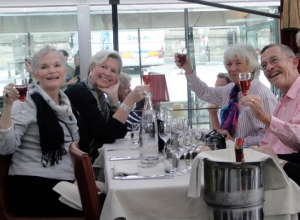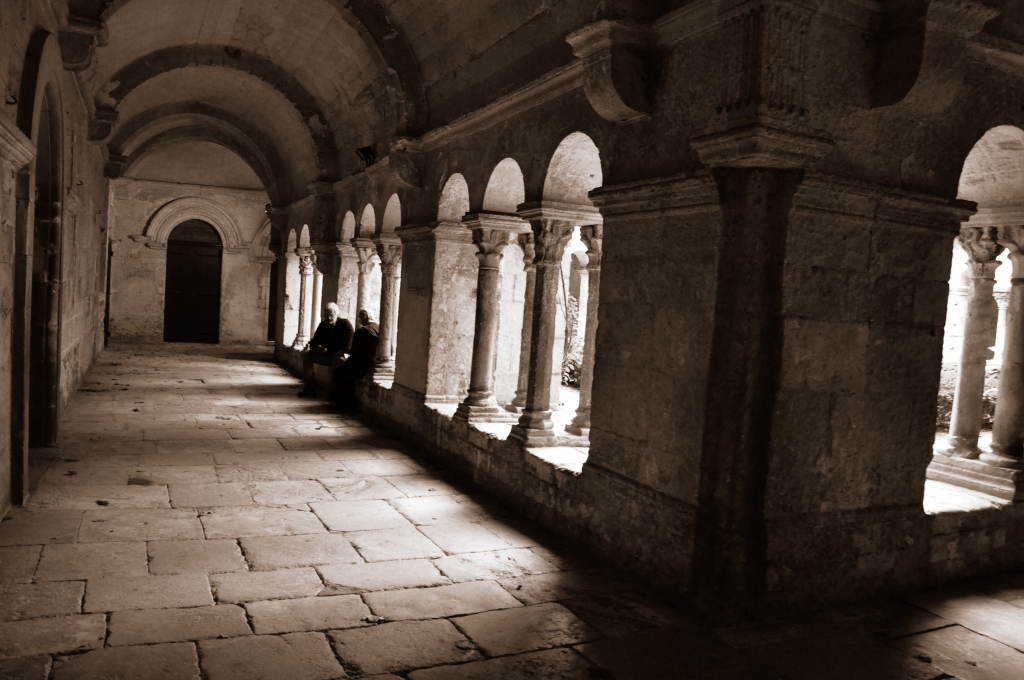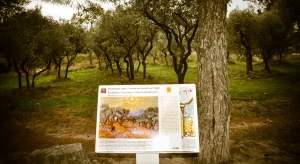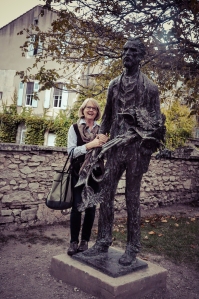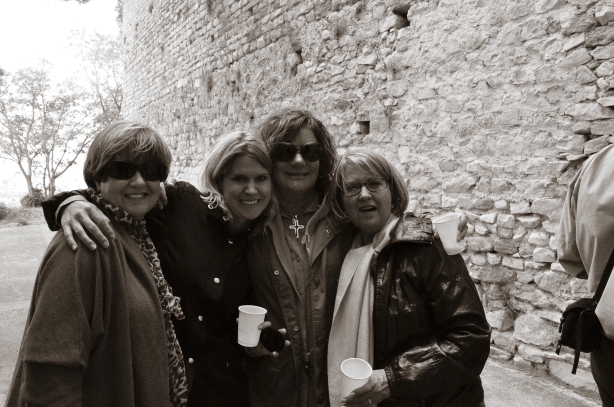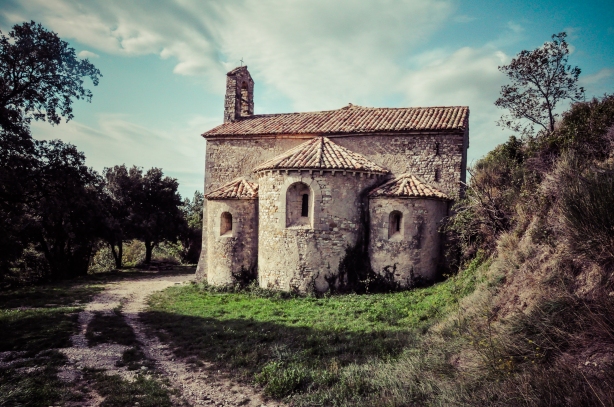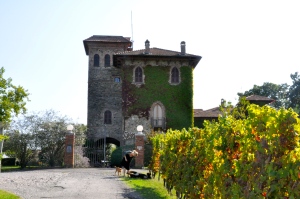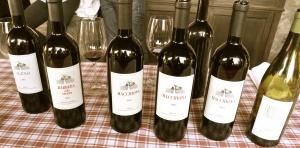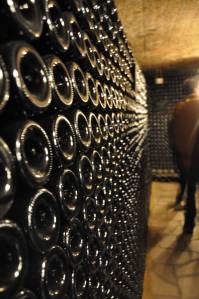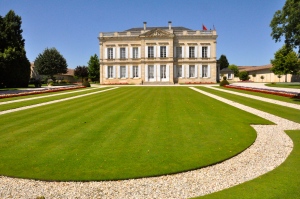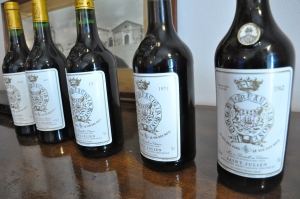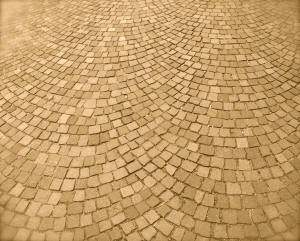This post is by Kay Pfaltz, Founder of Beyond Ordinary Travel.
Oh, there are so many and every time I think I’ve listed my favourites I remember twelve dozen more. No joke. But here are some winners, in different categories, mostly bistros, a few brasseries and restaurants. Keep this in mind, and no matter where you go, you’ll have a good meal. Even the local café offers a great salad or omelet with baskets of bread and good local, cheap house wine. I have not listed any three-star or even two-star Michelin restaurants but you might want to try at least one, just for the sheer quality of service and food. I have eaten more than once in all of the five (maybe now six) three-stars in Paris and it is an experience. Stroll, seek and enjoy…. Paris is a moveable feast.
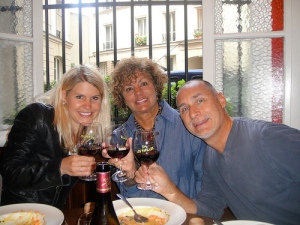
Happy bistro-goers at Les Papilles on Beyond Ordinary Travel’s Paris 2010 trip.
Classic bistros: A bistro has come to mean many things now. But it used to be a sort of Mom and Pop type of place with checkered tablecloths and mimeographed menus. Today there are simple, cheap bistros full of atmosphere and there are also very high-end, high quality bistros (like Benoit) full of atmosphere. Some of these below are considered both bistro and restaurant.
Polidor – 41, rue Monsieur-le-Prince, 6th. A historic bistro that has aged with grace. Hemingway, Joyce, many dined here. Regulars today still have their own napkins and rings. Regulars don’t even bother with the menu but just wait for the waitress to tell them what’s good. The snails are excellent. So is the pumpkin soup in season. Simple and cheap.
Chardenoux – 1, rue Jules-Valles, 11th. Beautiful Belle Epoque bistro. This is one of the prettiest. Look for the long zinc bar. Very French and authentic. Regulars flock here.
Le Vieux Bistro – 14, rue du Cloitre-Notre-Dame, 4th. I call this one the romantic bistro of Paris. Near Notre Dame on the Ile de la Cite, it can get touristy, but you’ll find surprisingly a lot of French.
La Fonaine de Mars – 129, rue St-Dominique, 7th. One of my favourite bistros. A true find in the fashionable and expensive 7th arrondissement. In nice weather sit outside near the fountain of Mars for which it’s named. Quintessential bistro. Order the assiette de cochonnailles de Laguiole or the Boudin aux pommes or the confit de canard.
La Tour de Montlhery – (Called Chez Denise by us locals!) 5, rue Prouvaires, 1st. Chez Denise is open 24 hours and gets really cranking after 9 or 10 pm. This is a carnivores delight and because of its location on the edge of the old Les Halles market (now torn down) it attracted the market vendors into the wee hours. A true institution, lively and wonderful. Everyone should go once. Order up the house Brouilly (Beaujolais), laugh and eat.
Le Petit Marguery – 9, blvd. Port-Royal, 13th. I love this bistro. It’s off the beaten path, in the 13th arrondissement but worth it. Food is excellent.
D’Chez Eux – 2, avenue Lowendal, 7th. In the elegant 7th arrondissement, this restaurant attracts a well-heeled crowd. Food is very, very copious. For instance if you order the crudités as an appetizer, you’ll be wheeled bowls upon bowls of salads and veggies. If you
Chez Réné – 14, blvd. St-Germain, 6th. I named the Basic Necessities Piggeries plate after a dish I had here once full of charcuterie (i.e. every pig product you can imagine.) Been around for a long time. Sit on the tree-enclosed wonderful terrace in the warm months and watch the world go by down the boulevard St. Germain.
Le Petit Pontoise – 9, rue de Pontoise, 5th. Great atmosphere, great food (all the best bistro specialties like boudin noir and kidneys and quiche and tarts for the less adventurous—nice tarte Tatin for dessert). A few outside tables. Very authentic except you may hear American voices since it was recently and unfortunately written up in the NY Times.
Le Rotisserie du Beaujolais – 19, quai de la Tournelle, 5th. Beside the famous Tour d’Argent, this rotisserie is owned by the son of M. Terrail (owner of Tour d’Argent). Having been to the famous and very expensive Tour d’Argent twice, I can say that this restaurant is my preferred choice. Only the view is secondary. This is a meat-eater’s place and if you want veggies (with the exception of mushrooms in fall), go elsewhere. Go early or call ahead and grab a window table and watch the people and the river beyond.
Les Papilles – 30, rue Gay-Lussac, 5th. Used to be somewhat hard to find more than a handful of good bistros in the 5th, but this relatively new one is excellent. 31 euro menu offers excellent, inventive cuisine.
Au Bon St-Pourcain – 10, bis, rue Servandoni, 6th. Walk into this tiny (26 seat) beauty in the shadow of St-Sulpice and you’ll think you’ve walked into (Billy) Wilderian Paris. Owner is former Deux Magots waiter François. Cheap and cheerful and ever so authentic. A find in touristy St-Germain.
Chez Paul – 13, rue Charonne, 11th. There are many Chez Pauls in Paris, but this one may be more people’s favourite restaurant than any other. It is heart-breakingly authentic. You’ll feel like you’re in a postcard. In the workingman’s 11th, a traditional bistro. Tables outside. Order up rabbit rilettes or steak au poivre with cognac.
Chez Janou – 2, rue Roger Verlomme, 3rd. There are two restaurants (not counting three-star L’Ambrosie and Ma Bourgogne which I mention next) on the place des Vosges that I love, but Chez Janou is just behind, away from the crowds, far enough away to keep the tourists at a distance and remain a nice little secret. It’s on a quiet little (almost) square with trees and a terrace for eating outside. It has 80 varieties of pastis so you can pretend you’re in sunny Provence! Even more so if you order up the petite friture d’eperlans (tiny whitebait, floured and friend and served in a basket with aioli on the side.) There’s a house salad of shrimp, avocado and grapefruit sections.
Ma Bourgogne – Place des Vosges, 4th. I keep coming back and back to this restaurant. I love the salads, big salades Nicoise etc. You can sit inside, but best is outside under the arcades of the Place des Vosges. This is where I ordered the carafe of Côtes du Rhône (in a wonderful cracked carafe) and they brought me the left over Beaujolais Nouveau and I took one sniff and sent it back stating I’d asked for the Rhone not Beaujolais. They were shocked that a lowly American knew the difference, and by a mere sniff. Wonderful setting. Check out the Victor Hugo museum at the far south eastern corner on your way out and also pass by three-star Michelin (remember 3 stars are as high as it goes in France) L’Ambrosie, same side as Ma Bourgogne.
Les Fete Galantes – rue Ecole Polytechnique, 5th. This place is tiny, but wonderful. Various ladies over the years have had such a good time, they shed their brasseries and there is a collection upon the wall. Also letters, like one by Kay. Bebe is the Moroccan owner and if you tell him you’re an American friend of Kay’s he’ll most likely ply you with free kirs (in hope of receiving a bra! Just kidding.) I used to bring legions of wine tasting students here twenty years ago. So carry on the tradition! Set menu, excellent value.
Perraudin – 157, rue St-Jacque, 5th. The quintessential bistro with its red and white table cloths and Art Deco tile floors, lace-curtained windows. Go in hungry, order a lot. The sole is excellent. Cheap, hearty, no-frills fare. Very traditional cooking. Leave stuffed.
Chez Lena et Mimile – 32, rue Tournefort, 5th. I include this marvelous set menu restaurant, because of the front terrace outside. Great value. Tartare of salmon is good, as is the duck.
Le Quincy – 28, avenue Ledru-Rollin, 12th. Excellent, traditional and up-scale bistro leaning towards southwestern specialties such as foie gras. Try the cassoulet au confit d’oie (goose).
Le Taxi Jaune – 13, rue Chapon, 3rd. Tiny, authentic bistro serving excellent traditional bistro fare. Unpretentious. Highly recommended.
Le Cordonnerie – 20, rue St-Roch, 1st. Excellent restaurant on the right bank. Really a restaurant and not a bistro. Traditional French cuisine in a 17th-century building.
Café Dalva – 48, rue D’Argou, 2nd. Not far from the Louvre and Palais Royal, Dalva offers very affordable food. Incredible terrace for dining.

Neo Bistros:
Albion – 80, rue du Faubourg Poissonière, 10th. This is a new bistro with excellent, inventive cuisine and traditional bistro interior. Office workers by day and trendy types by night. Open wine shelves, bistro chairs and tables, top quality food on daily changing chalkboard menus.
Au Bascou – 38, rue Reamur, 3rd. Outstanding Basque restaurant. This is a different experience, all Basque specialties. Real raw Basque ham; snails with garlic; roast lamb from the Pyrenéss. Really good and interesting wines. I have never had a bad meal. Grab the front table in the window.
Le Pre Verre – Many tables outside in this trendy restaurant in the Latin Quarter. Wine comes in the stemless glasses. Food is excellent. If on the menu, don’t miss the stunning sweetbreads. Noisy and hectic sometimes inside, but the food is definitely worth it.
I will stop here and if you go to none don’t worry. These are mere suggestions. There are many, many more favourites… in the 15th, 16th and 17th arrondissements. All over. I just can’t list all, but any good guide book is a good place to start and, as I think I said, the one you stumble upon even if café or chain is the one you’re supposed to be in. You really can’t go wrong in Paris.

A few clients enjoying a Paris wine bar
Wine bars: Le Rubis – 10, rue du Marché-St-Honoré, 1st. On the hidden place du Marche St-Honore sits this little wine bar on the corner…that’s been there forever…or so it seems. Food is classic, copious and cheap. Have a glass of Côtes du Rhône for 3 euros. Dine well for under 20 Euros. Popular with the business lunch crowd.
Juvenile’s – 47, rue de Richelieu, 1st. A tiny wine bar near the Bibliotheque National (National Library) where yours truly K. Pfaltz sat for hours in the big womb of a reading room working on her doctoral dissertation (i.e. day-dreaming). Apparently the B.N. as it’s called in Paris, is a great pick-up place. Sadly that fact was lost on me as no one ever picked me up! Back to Juvenile’s: It is another delightful and affordable experience. Grilled quail, curried lamb, duck breast with sautéed potatoes and greens. Most entrees under 9 euros (remember entrée in France means starter, i.e. before the main course) and the plates (or main courses) are 15 to 16 euros. To finish the meal try one of Bernard Boisson’s (of Maison Audry) incredible cognacs.
La Taverne Henri IV –13, place du Pont-Neuf. This place on the tip of the Ile de la Cite has been around for a long time. It’s often filled with magistrates or lawyers from the nearby Palais de Justice. The square across from it on the tip of the island is called Square de Vert Galant after Henry IV whose statue stands above on the Pont Neuf (new bridge which in true French logic is the oldest in Paris.) To get to the Square de Vert Galant take the stairs down towards the Seine. Pose for a photo under the beautiful sweeping willow. The square behind the wine bar/tavern is also worth wandering around. It houses a couple famous restaurants (Chez Paul) and was famous as the residence of Yves Montand. But it’s worth it to stroll the leafy little park (place Dauphine) for its quiet, peaceful elegance. Inside at the tavern, dine on the usual wine bar fair and drink excellent cuvees of wine.
Willis Wine Bar – 13, rue des Petits-Champs. Willie’s is owned by Englishman, Mark Williamson and ironically may be one of the best wine bars in Paris. “Willie’s” passion is for the wines of the Rhone and here is a fabulous offering. Food is excellent, more restaurant style than bistro. Not nouvelle cuisine, just a bit more delicate. You’ll not be disappointed by either food or wine.
Jacques Melac – 42, rue Leon-Frot, 11th. One of the most authentic and liveliest wine bars in Paris. In the workingman’s 11th, an arrondissement filled with cabinetmakers and artisans, this wine bar offers real Auvergnat dishes. Worth the trek.
L’Excluse – 15, place de la Madeleine, 8th. And other locations. A wine bar chain but not like our chains in the US! i.e. Waffle House! Serves good food and exclusively Bordeaux. An inexpensive way to try some really good wines.
Best wine shop in the world?
Lavinia – boulevard du Madeleine. Actually started in Spain, but this is the Paris branch.
Brasseries: Brasseries are bigger than bistros, and more brightly lit. They were the old beer houses of Franch, so you’ll find beer, but also good Alsatian wines. You can always find good seafood food platter (plateau fruits de mer) but keep in mind, usually raw. Also the Alsatian influence means you’ll find such specialties as Choucroute (sauerkraut) on the menu. The Boucher/Flo group has bought out just about all of the old famous ones. I (and most Parisians) have mixed feelings as it means these old places are now really a chain, but you’d never know it. Go to at least one.
Brasserie Balzar – 49, rue des Ecoles, 5th. Historic brasserie (more bistro sized) that was finally bought out by the Flo Group. Food is decent, atmosphere superb, still frequented by politicians, philosophers and the intellectual elite.
La Coupole –102, blvd du Montparnasse, 14th. After seven or eight decades La Coupole remains one of the most authentically Parisian scenes, with its bustling and solidly professional waiters, young families, old couples, singles and of course for many years…Lauren! It was here we celebrated her birthday.
Brasserie Flo – 7, cour Petites-Ecuries, 10th. An honest 1900s Alsatian brasserie with a faithful, flashy Parisian clientele. Noisy, hectic but for many regulars that’s part of the charm.
Julien – 16, rue du Faubourg St-Denis, 10th. Despite the rather seedy location, Julien remains one of the city’s most chic, most popular nighttime addresses. Look inside this bright, stunning 1890s dining hall and you’ll understand. Better yet dine there.
Brasserie Lipp – 151, blvd St-Germain, 6th. One of the city’s most famous café- restaurants. Still a late-night spot for politicians and designers and editors. During the day can be cramped with Americans or Japanese on the terrace. Hemingway wrote beautifully about Lipp.
Bofinger – 5, rue de la Bastille, 4th. One of the prettiest brasseries in Paris, festive and classy with attentive service. Try the choucroute (sauerkraut).
Bouillon Racine – 3, rue Racine, 5th. Great location in the Latin Quarter. Beautiful, Belle Epoque Brasserie.
Vaudeville – 29, rue Vivienne, 2nd. A lively 1925 brasserie full of mirrors and marble and the sounds of great times. In warm weather opt for a table outside facing the imposing Bourse, or stock exchange. Order up carafes of the house Riesling and feast on oysters etc. Flash once jumped out of his carry bag (this was after the days of Lauren) and ran into the kitchen. No joke.
Falafel:
Chez Marianne – On the corner of the rue des Rosiers (heart of the Jewish section) this is a great place to order take out falafel. Pay inside and take a ticket, then wait in line outside. Find a park around the corner, buy water, sit and eat! Or you can sit inside and order up the wonderful eastern European specialties and don’t miss all the wonderful pastries.
Oysters:
Oysters are eaten in the winter months, i.e. the months with “R” in them, not because oysters will harm you in the summer months, but because the warm months are the spawning season and the oysters tend to be thin and watery. But what better time to slip down some oysters with cool glass of Sancerre than in summer time? Raw oysters in France are not served with cocktail sauce (shudder, how American) but with sauce Mignonette, a mixture of shallots and vinegar. I personally prefer just a squeeze of lemon. You will find oysters in all of the Brasseries. Order a large plateau fruits de mer or fruits of the sea! Seafood, most of which will be raw.
Huiterie Régis – 3, rue de Montfaucon, 6th. One of the best. Order a plateau fruits de mer, a bottle of Muscadet or Sancerre and sit back and watch le tout Paris.
La Coupole – See brasseries.
Famous Cafés: Cafés are where life takes place in Paris. Order a café and sit back for hours and watch the world go by. Listen to the voices behind you; you’ll hear many languages; you’ll hear talk of politics, art and philosophy. Cafés are everywhere, from the working man’s corner café to the famous (and for that reason touristy) ones I list below.
La Rotonde – 105, blvd du Montparnasse, 14th. Lenin and Trotsky sipped their crèmes here in 1915 along with others of the international intelligentsia who made the café famous. The Americans (Hemingway, Fitzgerald etc.) hung out in the cafés of Montparnasse in the 20s and 30s. Le Dome across the street (also good for seafood) and Le Select next door.
Aux Deux Magots – 170 blvd. St-Germain, 6th. After the war the intellectual center shifted and St-Germain, not Montparnasse, became the place to be. Sartre and de Beauvoir sat and wrote here. This is probably the ultimate Parisian café and good to go to once. Make sure to go inside or if you can sit inside as the terrace gets mighty touristy, but it’s fun. Great coffee and great hot chocolate. But not cheap.
Café de Flore – 172, blvd. St-Germain. Next door to Deux Magots. More of a literary hangout and popular with Sartre, de Beauvoir and Albert Camus. Perhaps my favourite café in Paris. I wrote some of A Walk Through Paris at an upstairs table looking out the window. Upstairs is not very scenic though.
La Palette – 40, rue de Seine, 6th. This café, the artists hangout, is perfect on a sunny afternoon. Good sandwiches made on Paiin Poilane. Out of the way, so a bit more trendy than the touristy ones on St. Germain.
Café de la Marie – 8 place St. Sulpice, 6th. On the place St-Sulpice this café must have one of the best locations in all of Paris. Try to grab a seat out front just for the experience. And don’t be surprise is you see Catherine Deneuve walk by doing her own shopping, she lives at number 76, rue de Bonaparte. Just don’t run up to her or snap a photo. The Parisians respect the privacy of others, a concept we’d do well to honour in the U.S.
Café Delmas – This café on the place de la Contrescarpe in the 5th arrondissement is right across from my old apartment. The square now has a lovely fountain but once upon a time it was just a bit of raised concrete and the bums hung out there. I knew them all. My address was 57, rue Lacepede across the square and I had the three windows on the first floor (yellow tinted window is the bathroom, to the left the living room, to the left of it the kitchen.
This is the blog of Beyond Ordinary Travel, an organization providing tours and experiences for travelers who enjoy high quality travel. If you’d like to join our group of travelers, please visit beyondordinarytravel.com.

